Royalty
The (upside down?) art of Prince Andrew
Prince Andrew has been in the news lately, but this post isn't about the various scandals besetting him. Instead, it's about the prince's brief foray into the world of art, when he was a teenager.At the age of 17, he completed an oil painting which he titled "Canadian Landscape." It was displayed at the Windsor Festival, which was an exhibition that gathered together works related to the Royal Family from Tudor times to the present.
I'm sure his painting must have been in color, but the AP image archive has a photo of it in black-and-white. As seen below.

As I was looking at the picture, I kept thinking that it didn't visually make much sense. Of course, perhaps it was intended to be an abstract work, but out of curiosity I flipped it around, at which point it immediately made a lot more sense. At least, I think so. See below for comparison. So, I'm pretty sure that the AP archive has his picture upside-down — and it's had it that way for years.

What I wonder is if this is just a screw-up by the AP archive, or was his painting actually displayed that way? Does Prince Andrew's painting deserve a place in the WU Gallery of Art Hung Upside-Down?
Posted By: Alex - Fri Nov 22, 2019 -
Comments (3)
Category: Art, Royalty
King Vitaman Cereal
Because the Middle Ages were known for healthy eating.The Wikipedia page.
Posted By: Paul - Thu Sep 05, 2019 -
Comments (3)
Category: Food, Royalty, Stereotypes and Cliches, 1960s
Follies of the Madmen #382
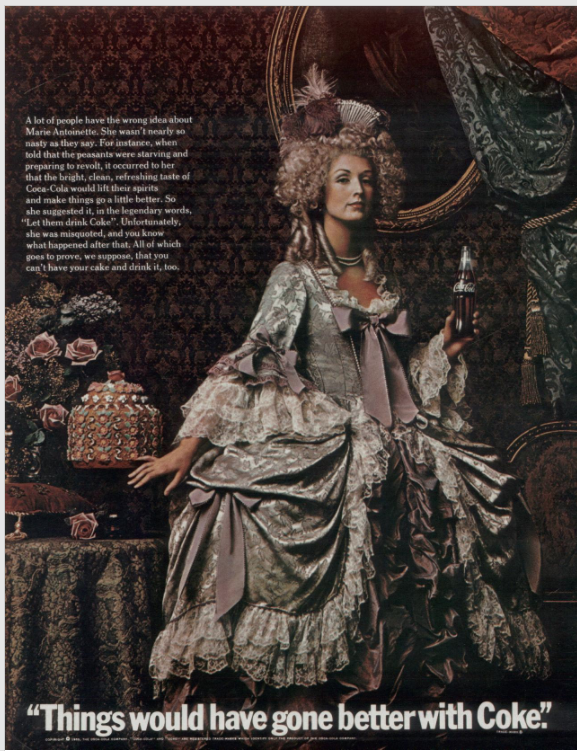
Associating your product, even in jest, with reviled aristocrats: not the smartest move.
Original ad here.
Posted By: Paul - Tue Sep 11, 2018 -
Comments (7)
Category: Business, Advertising, Royalty, Soda, Pop, Soft Drinks and other Non-Alcoholic Beverages, 1960s
Why a Monkey on the Leinster Coat of Arms?
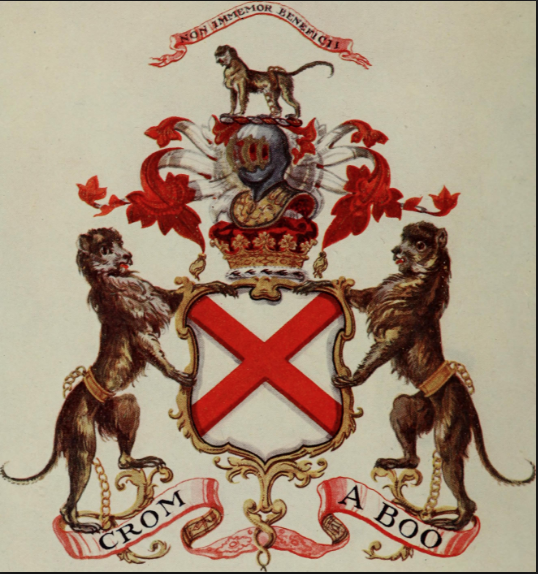
"The coat of arms of the Dukes of Leinster derives from the legend that John FitzGerald, 1st Earl of Kildare, as a baby in Woodstock Castle, was trapped in a fire when a pet monkey rescued him. The FitzGeralds then adopted a monkey as their crest (and later supporters) and occasionally use the additional motto Non immemor beneficii (Not forgetful of a helping hand)."
The Wikipedia page.
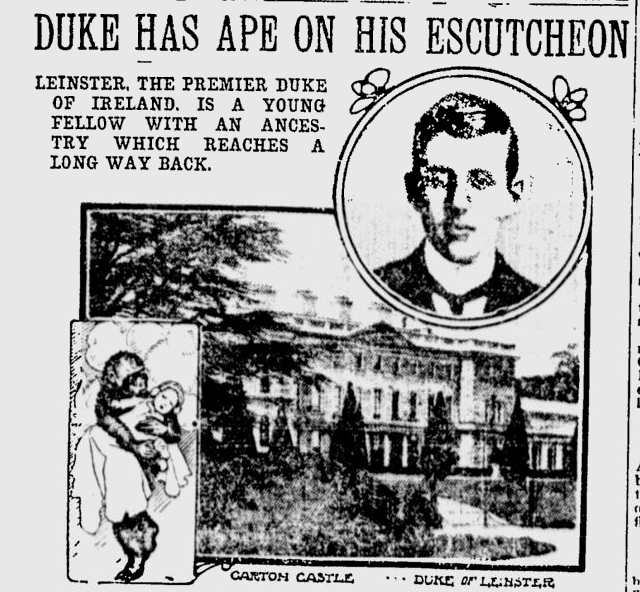
Article source.
Posted By: Paul - Thu Jul 19, 2018 -
Comments (1)
Category: Animals, Royalty, Eighteenth Century
England’s Poorest Baronet
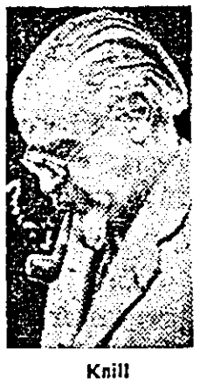
Knill was born into wealth. It was his grandfather, Stuart Knill, who was made the first Knill Baronet in 1893 (official title: Baronet Knill, of The Grove, Blackheath and Fresh Wharf, London). The 1st and 2nd Knill Baronets both served for a time as Lord Mayors of London.
Sir John Stuart Knill became the 3rd Baronet after the death of his father in 1934. However, he never actually registered the title, which meant that his Baronetcy was officially considered to be dormant, but that was a minor detail overlooked by the press.
Knill's fortunes began to go south after World War I. He lost his family's ancestral estate, Knill Court in Herefordshire, and fell back on his knowledge of antiques to make a living, opening an antique shop in Brighton. However, the shop failed to make a profit, so by the mid-1930s he had closed it and began operating a "bric-a-brac stall" in London's Caledonian market. On the weekends he swept streets.
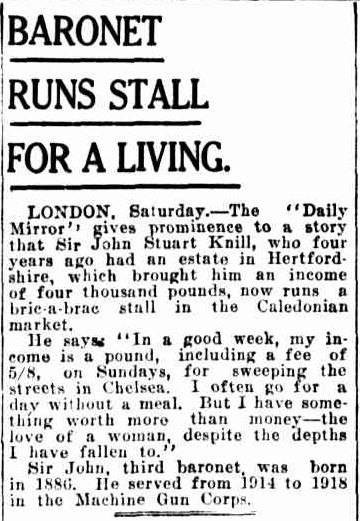
The Burnie Advocate - Apr 12, 1937
A job as a postman followed during the 1940s. His wife, Lady Ruth Evelyn Knill, supplemented the family income by working as a mill girl. Interviewed in 1950, she said, "We've lived hard and now we are down to rock bottom. I'm living up to my name. Of money, we have: Knill."
The Knills earned extra cash by breeding animals in their rented apartment, but due to failure to pay the rent they were evicted in 1951 and moved into public housing.
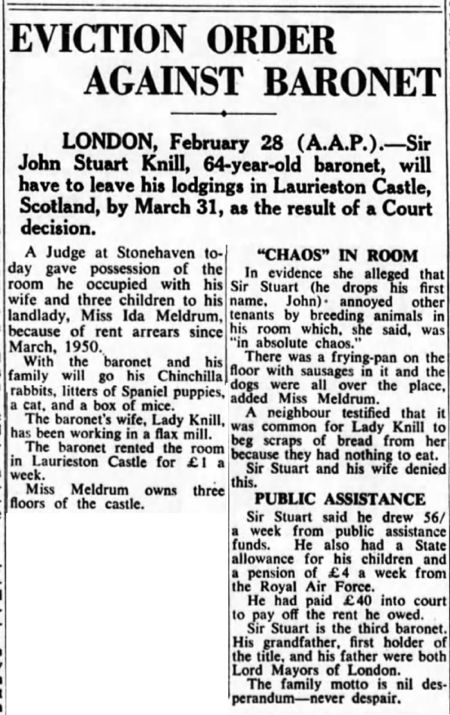
Sydney Morning Herald - Mar 1, 1951
The next time Knill made headlines was in 1962 when it was widely reported that he was "trying to recoup his lost fortune by hypnotizing his wife so she can win the weekly soccer pool." As reported by UPI:
So far the pursuit of riches in England's national pastime has failed to yield the results they hope for but this has not dampened their enthusiasm...
Both feel that their lack of success may be due to poor reception by Lady Knill.
"It seems to depend on the weather for accuracy," she said. "On a dull day I have a job to 'read' the results. Normally, when he hypnotizes me the TV set appears to be switched on. Sometimes it seems so bright that I have to ask him to tone it down."
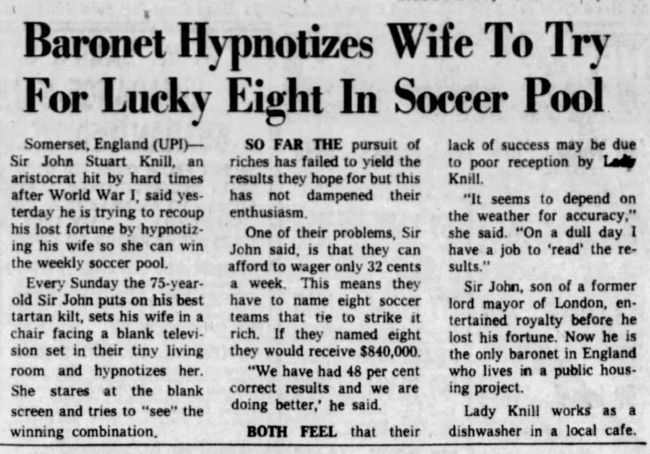
The Indianapolis Star - Mar 10, 1962
Knill died in 1973 at the age of 87. His son John (the 4th Baronet) was also quite a character. He was a long-time campaigner for the preservation of canals and was known around the city of Bath as a local eccentric, "propelling himself in a wheelchair operated by an astonishing system of levers, pulley and - it has to be said - cranks." More info about him here.
Posted By: Alex - Wed Dec 28, 2016 -
Comments (2)
Category: Eccentrics, Royalty
The Royal Handbag Code

While on a lecture tour of the United States in 1990, Raymond Fullager, an expert on the British royal family, revealed the existence of a royal handbag code. According to him, the Queen of England used her purse to communicate secret signals to her staff.
Fullager claimed to have identified 23 different signals she used. For instance, if she moved her purse from her right to her left arm it meant that she was bored and needed to be rescued. A lady-in-waiting would then approach and say, "I'm afraid, ma'am, that you are running 10 minutes behind schedule."
If the handbag was securely gripped on her left arm, it meant that all was well.
Fullager refused to reveal all 23 signals, insisting that they needed to be kept a royal secret. But he did share some of the Queen's other body-language code. For instance, if she rubbed the middle finger on her left hand, it meant that a spectator was getting too close.
However, other royal experts were skeptical of Fullager's handbag-code theory. Gossip columnist Nigel Dempster declared that the code theory was "silly" and "just rubbish."
Andrew Morton said, "Frankly, you've got to wonder if anyone can actually do 23 different things with a handbag."
More info: Philly.com (Sep 14, 1990)

LA Times - Aug 8, 1990
Posted By: Alex - Tue Aug 23, 2016 -
Comments (4)
Category: Languages, Royalty
Three Thousand Deer Trophies
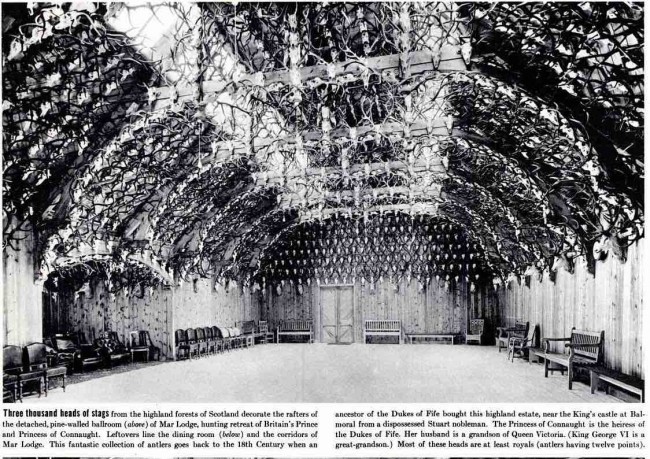
[Click to enlarge]
Original pic here.
Wikipedia entry here.
Posted By: Paul - Fri May 27, 2016 -
Comments (8)
Category: Animals, Hunting, Trapping and Other Wilderness Activities, Royalty, 1930s, Europe
The Jokes of King George VI
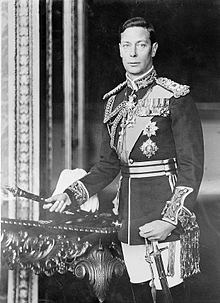
- [In response to a speaker who was praising him in extravagant terms]. "I am reminded," he said, "of the woman who went to her husband's funeral service. The couple had never got on well together, but the minister devoted his long sermon to a panegyric of the husband's virtues. So glowing a picture did he paint that the widow completely failed to recognize her late husband. 'Milly,' she nudged her friend and whispered loudly, 'is there another corpse about?'"
- There was a petrol dump where men sent a canary down into the empty tank to see if the atmosphere was safe for them to go down and clean it out. One day the foreman saw a man walking about in the bottom of the tank before the canary had been let down. "Hey, what are you doing there?" he yelled. In all seriousness the man below shouted back: "I'm just seeing if it's all right for me blinkin' canary."
Posted By: Alex - Sat Apr 27, 2013 -
Comments (0)
Category: Humor, Jokes, Royalty, 1930s
King Ding Dong
If only the psychedlic-era King Ding Dong had been allowed to rule the Hostess company, they might still be with us today.
Posted By: Paul - Thu Apr 11, 2013 -
Comments (6)
Category: Anthropomorphism, Royalty, Advertising, Chocolate, Junk Food, 1970s
Queen Elizabeth, Teenybopper

[Original article here.]
Courier Mail Wednesday 19 September 1956
The Queen sees Rock 'n' roll Film
London. September 18. (AAP)- Queen Elizabeth has asked to see the film “Rock Around the Clock” which has led to rock 'n' roll disturbances in several British towns.
A copy of the film was sent from London yesterday to Balmoral, where the Queen is on holiday, the Daily Mirror said today.
The Daily Express reported that showings of “Rock Around the Clock” has been banned by country councils in Stockport, Cheshire, and Gloucestershire yesterday.
But at Burt St. Edmunds in Suffolk, no objections were raised by members of a watch committee after a private showing of the film.
Sir Malcolm Sargeant, conductor of the BBC symphony orchestra, said to day that rock 'n' roll music was “nothing more than an exhibition of primitive tom tom thumping, and was ‘centuries old’. It was not ‘new and wonderful’ as many young people thought. It had been played in the jungles for centuries.”
At age 86, Queen Elizabeth reminds no one of a rocker--although she does hand out a lot of knighthoods to musicians. But in 1956, at age 30, she could really groove.
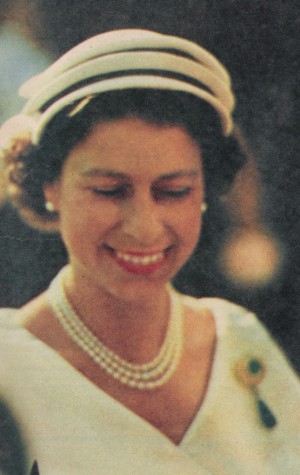
She was obviously remembering those days in 1979, when she and Bill Haley reconnected for the first time in nearly 25 years.
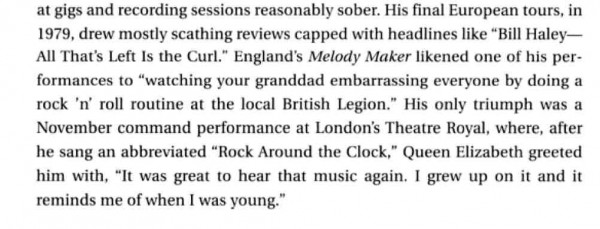
[Original text here.]
Posted By: Paul - Tue Dec 04, 2012 -
Comments (3)
Category: Music, Royalty, 1950s, Europe

| Who We Are |
|---|
| Alex Boese Alex is the creator and curator of the Museum of Hoaxes. He's also the author of various weird, non-fiction, science-themed books such as Elephants on Acid and Psychedelic Apes. Paul Di Filippo Paul has been paid to put weird ideas into fictional form for over thirty years, in his career as a noted science fiction writer. He has recently begun blogging on many curious topics with three fellow writers at The Inferior 4+1. Contact Us |




